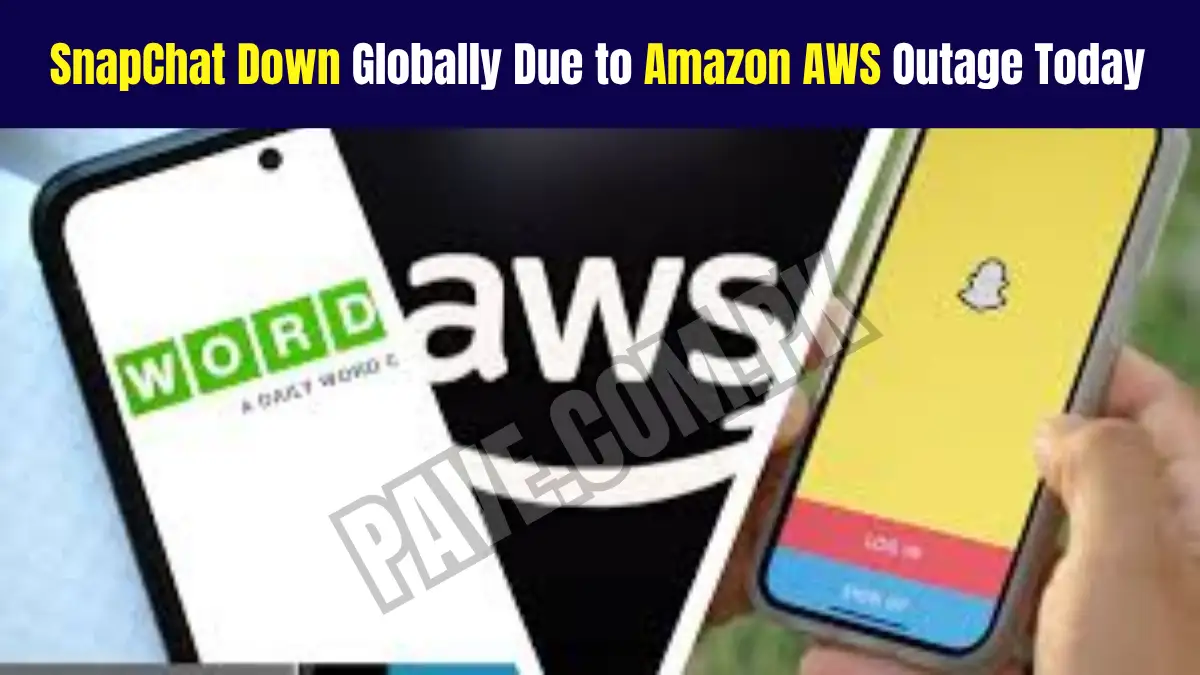SnapChat Down Globally Due to Amazon AWS Outage Today
In a shocking turn of events today, SnapChat Down Globally Due to Amazon AWS Outage Today, leaving millions of users unable to send snaps, messages, or even log in. What started as a few isolated complaints quickly turned into a worldwide disruption, exposing how dependent today’s most popular apps are on cloud infrastructure.
The Snapchat outage today became one of the biggest tech stories of 2025, with users from the U.S., U.K., Europe, Asia, and Pakistan reporting that the app simply stopped working. From “Could not connect” errors to complete service unavailability, the incident revealed how fragile even the most powerful social platforms can be when a global cloud provider faces issues.
What Happened to Snapchat Today?
The trouble began early Monday morning when Amazon Web Services (AWS) — the world’s leading cloud computing platform — confirmed a “major operational disruption” in its US-EAST-1 region (Northern Virginia). Within minutes, apps relying on AWS servers began failing, and Snapchat was one of the first major casualties.
Snapchat’s servers, like many global applications, depend heavily on AWS for storage, real-time communication, and login authentication. As the AWS systems struggled, millions of Snapchat users were suddenly locked out. Reports of “Snapchat not working globally” flooded DownDetector, X (formerly Twitter), and Reddit, peaking with over 100,000 outage reports in less than an hour.
A Global Breakdown – Not Just a Local Glitch
This was not an isolated event. From New York to Lahore and from London to Sydney, users faced the same frustrating problem: messages failed to send, stories refused to load, and the app either froze or crashed instantly.
In Pakistan, Snapchat users began trending #SnapchatDown by mid-afternoon, while similar hashtags appeared in India, Indonesia, and the Middle East. The Snapchat server status 2025 dashboard later confirmed “global connectivity disruptions due to upstream service providers.”
Several other platforms — including Fortnite, Signal, Venmo, and Prime Video — were also hit. This made it clear that the real culprit was the Amazon AWS outage 2025, not Snapchat itself. When AWS goes down, thousands of websites and apps get caught in the storm.
Read More: Snapchat Outage October 2025
Why Did Amazon AWS Go Down?
AWS powers a huge portion of the internet. Whenever it suffers from an internal malfunction — like today’s network congestion and increased error rates — it can disrupt everything from social media apps to banking systems.
According to Amazon’s preliminary statement, the US-EAST-1 region experienced connectivity and latency issues due to “internal system propagation delays.” In simple terms, the servers that route global traffic became overloaded and stopped communicating properly.
This resulted in delayed or failed login requests, message queuing problems, and total service denial for apps like Snapchat that depend on real-time cloud infrastructure.
Snapchat Users React Online
The Snapchat down report worldwide went viral within minutes. Frustrated users took to social media to express their confusion and amusement:
“I thought I got logged out for no reason — turns out Snapchat’s broken everywhere!”
“When Snapchat goes down, I realize how much I use it to talk to everyone.”
“Not me deleting and reinstalling Snapchat five times thinking my phone’s the issue.”
The outage even sparked memes comparing the event to past internet “meltdowns,” such as the WhatsApp and Facebook global outages of previous years.
Timeline of the Outage
Let’s break down what happened step-by-step:
| Time (ET) | Event Summary |
|---|---|
| 3:05 AM | AWS reports technical issues in its U.S. region. |
| 3:20 AM | Snapchat users begin reporting login failures globally. |
| 3:45 AM | Outage confirmed by major tech monitoring platforms. |
| 4:00 AM | AWS acknowledges “elevated error rates” across multiple services. |
| 4:30 AM | Snapchat team issues a statement: “We’re aware some users are having trouble.” |
| 5:15 AM | Partial recovery begins in Europe and Asia. |
| 6:30 AM | AWS engineers report “stabilizing infrastructure.” |
| 7:00 AM onward | Gradual service restoration across most regions. |
By mid-day, most users could access Snapchat again, but not all features were fully restored. Some noticed lag in sending Snaps or viewing Stories.
The Ripple Effect: How AWS Outages Shake the Internet
The Amazon AWS outage 2025 wasn’t just a Snapchat problem — it affected hundreds of online services. Many users also reported problems with Alexa, Discord, Reddit, Shopify, and even some banking apps.
Because so many businesses depend on AWS, a single regional disruption can cause massive global downtime. It’s like having the power go out in one data hub and watching entire online cities go dark.
This outage revealed a critical truth about today’s internet: a few big players (like AWS, Google Cloud, and Microsoft Azure) hold enormous control over online infrastructure. When one of them stumbles, billions feel it instantly.
How Snapchat Responded
Snapchat’s official X account confirmed the issue early in the day:
“We’re aware that some Snapchatters are having trouble using the app. We’re working with our partners to resolve the issue as quickly as possible.”
The company coordinated directly with Amazon engineers throughout the day. Once AWS reported “significant improvement in network performance”, Snapchat services began returning to normal in waves.
Behind the scenes, Snapchat temporarily rerouted some of its backend services to backup clusters to handle incoming traffic until AWS systems stabilized.
What This Means for Tech Companies
The incident has reignited the debate about over-reliance on centralized cloud providers. For Snapchat and others, this outage shows the need for “multi-cloud” strategies — spreading infrastructure across multiple providers to reduce risk.
Industry analysts believe this event could lead major platforms to diversify their systems. As one cybersecurity expert noted:
“The Snapchat outage today underscores how a single region failure can cripple half the world’s apps. It’s a wake-up call for digital resilience.”
In the coming days, we may see companies auditing their backup systems, implementing additional fail-safes, and increasing investments in cloud redundancy to avoid repeating today’s chaos.
What Users Can Do During Outages
If you’re ever caught in a global tech outage like this one, here are a few smart steps:
- Don’t panic – It’s usually a widespread issue, not your device.
- Check trusted platforms – Use websites like DownDetector or X to see if others are reporting the same issue.
- Avoid multiple login attempts – Too many failed tries may trigger account locks.
- Wait for official updates – Both Snapchat Support and AWS post regular status updates during major incidents.
- Use alternate platforms – Temporarily switch to WhatsApp, Telegram, or Instagram to stay connected.
For many users today, following these simple steps saved a lot of time and stress while waiting for Snapchat’s systems to recover.
Global Impact Overview
| Region | Status During Peak Outage | Recovery Time |
|---|---|---|
| North America | Severe disruption | 2–3 hours |
| Europe | Major login failures | 1.5–2 hours |
| Asia (including Pakistan & India) | Partial access, high lag | 3–4 hours |
| Middle East | Service unavailable | 2 hours |
| Australia | Limited messaging | 1 hour |
The pattern shows how interconnected global networks are — an AWS glitch in one region can ripple across continents within minutes.
Expert Insights
Tech analysts believe this was one of the largest infrastructure-related outages of 2025 so far. It also offered a valuable lesson in system design and user communication.
When asked about the Snapchat login issue today, analysts noted that transparency is key. Platforms that keep users informed — even with brief updates — tend to retain trust better than those that stay silent. Snapchat’s quick acknowledgment helped ease some user frustration.
Furthermore, Amazon’s response time was considerably faster compared to its previous outages, showing improvement in crisis management. However, experts suggest AWS still needs better geographic isolation for critical services.
Read More: Canva Down Today 2025
The Numbers Behind the Outage
- Affected users: Estimated 150 million + globally.
- Peak downtime: Around 2 hours 45 minutes.
- Top affected countries: U.S., U.K., India, Pakistan, UAE, Australia.
- Peak DownDetector reports: Over 120,000 within 30 minutes.
- Financial impact: Yet to be estimated, but experts predict millions in lost ad revenue for major apps.
What Happens Next?
As systems stabilize, both Snapchat and Amazon AWS are expected to release detailed post-incident reports explaining what went wrong. Snapchat may also roll out minor app updates to optimize performance and reduce dependency on single-region cloud nodes.
This event could become a case study for cloud resilience — influencing how companies architect their platforms in the years ahead. It’s also a reminder for governments and businesses to plan for digital continuity, ensuring essential communication tools remain functional even during large-scale outages.
Conclusion
The phrase “SnapChat Down Globally Due to Amazon AWS Outage Today” perfectly sums up this extraordinary day in tech. Millions of users experienced firsthand how one infrastructure hiccup can disrupt the digital heartbeat of the modern world.
While the Snapchat outage today caused frustration, it also shed light on the hidden mechanics of the internet — the unseen cloud networks that keep our apps alive. As AWS systems recover, services are gradually returning to normal, and users can once again send their snaps, share their stories, and scroll through filters.
Today’s event serves as a major reminder for tech companies everywhere: no matter how advanced an app is, the entire system is only as strong as the cloud beneath it.







